
III(2)_Unit_4_Communication_ST
.pdf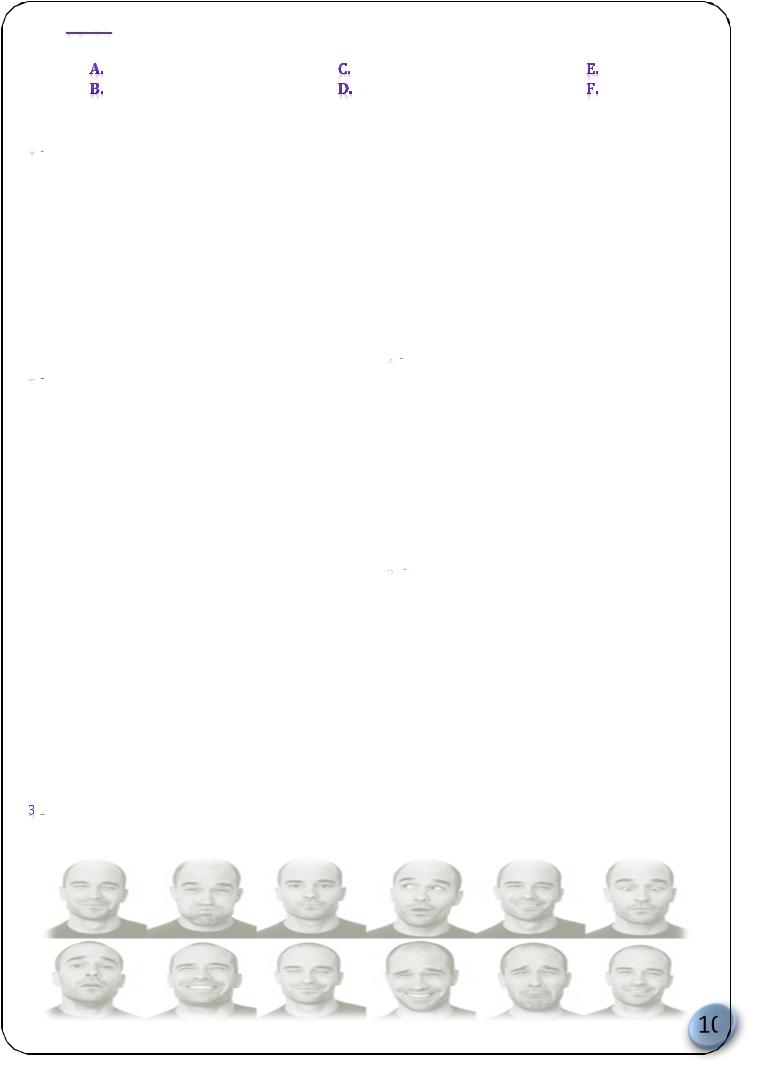



 Read the text and match one of the headingsA-F to each of the five sections.
Read the text and match one of the headingsA-F to each of the five sections.
Eye contact |
Smile |
Open posture |
Forwardlean |
Stand close |
Touch |
 A pleasant smile is a strong indication of a friendly and open attitude and a willingness to communicate. It is a positive, nonverbal signal sent with the hope that the other person will smile back. When you smile, you demonstrate that you have noticed the person in a positive manner. The other person considers it a compliment and will usually feel good. The result? The other person will usually smileback.
A pleasant smile is a strong indication of a friendly and open attitude and a willingness to communicate. It is a positive, nonverbal signal sent with the hope that the other person will smile back. When you smile, you demonstrate that you have noticed the person in a positive manner. The other person considers it a compliment and will usually feel good. The result? The other person will usually smileback.
Smiling does not mean that you have to put on a phony face or pretend that you are happy all of the time. But when you see someone you know, or would like to make contact with, do smile. By smiling, you are demonstrating an open attitude to conversation.
 You might not realize that closed posture is the cause
You might not realize that closed posture is the cause
of many conversational problems. Typical closed posture is sitting with your arms and legs crossed and your hand covering your mouth or chin. This is often called the "Thinking pose." but just ask yourself this question: Are you going to interrupt someone who appears to be deep in thought? Not only does this posture give off "stay away" signals to others, but it also prevents your main "signal sender" (your mouth) from being seen by others looking for receptive conversational signals. Without these receptive signals, another person will most likely avoid you and look for someone who appears to be more available for contact To overcome this habitual way of standing or sitting, start by keeping your hands away from your mouth and keep your arms uncrossed. Crossed arms lend to indicate a defensive frame of mind, and thus one not particularly favorable to outside contact. They can also indicate impatience, displeasure, or judgment - any of which would discourage people from opening up.
Open posture is most effective when you place yourself within communicating distance of the other person - that is, within about five feet [~1.5m]. Take care, however, not to violate someone's “personal space” by getting too close, too soon.
 Leaning forward slightly while a person is talking to
Leaning forward slightly while a person is talking to
you indicates interest on your part, and shows you are listening to what the person is saying. This is usually taken as a compliment by the other person, and will encourage him to continue talking.
Often people will lean back with their hands over their mouth, chin, or behind their head in the "thinking" pose. This posture gives off signals of judgment, skepticism, and boredom from the listener. Since most people do not feel comfortable when they think they are being judged, this leaning-back posture tends to inhibit the speaker from continuing.
It's far better to lean forward slightly in a casual and natural way. By doing this, you are saying: “I hear what you're saying, and I'm interested - keep talking!" This usually lets the other person feel that what he is saying is interesting, and encourages him to continue speaking.  In many cultures the most acceptable form of first
In many cultures the most acceptable form of first
contact between two people who are just meeting is a warm handshake. This is true when meeting members of the same or opposite sex - and not just in business, but in social situations, too. In nearly every situation, a warm and firm handshake is a safe and positive way of showing an open and friendly altitude toward the people you meet
Be the first to extend your hand in greeting.Couple this with a friendly ‘Hello', a nice smile, and your name, and you have made the first step to open the channels of communication between you and the other person.
 The strongest of the nonverbal gestures are sent
The strongest of the nonverbal gestures are sent
through the eyes. Direct eye contact indicates that you are listening to the other person, and that you want to know about her.
Eye contact should be natural and not forced or overdone. It is perfectly okay to have brief periods of eye contact while you observe other parts of the person's face - particularly the mouth. When the person smiles, be sure to smile back. But always make an effort to return your gaze to the person's eyes as she speaks. It is common to look up, down, and all around when speaking to others, and it's acceptable not to have eye contact at all times.
Too much eye contact, especially if it is forced, can be counterproductive. If you stare at a person, or leer in a suspicious manner, the other person may feel uncomfortable and even suspicious about your intentions. A fixed stare can appear as aggressive behavior if it takes the form of a challenge as to who will look away first.
Unit 4: Student’s Book
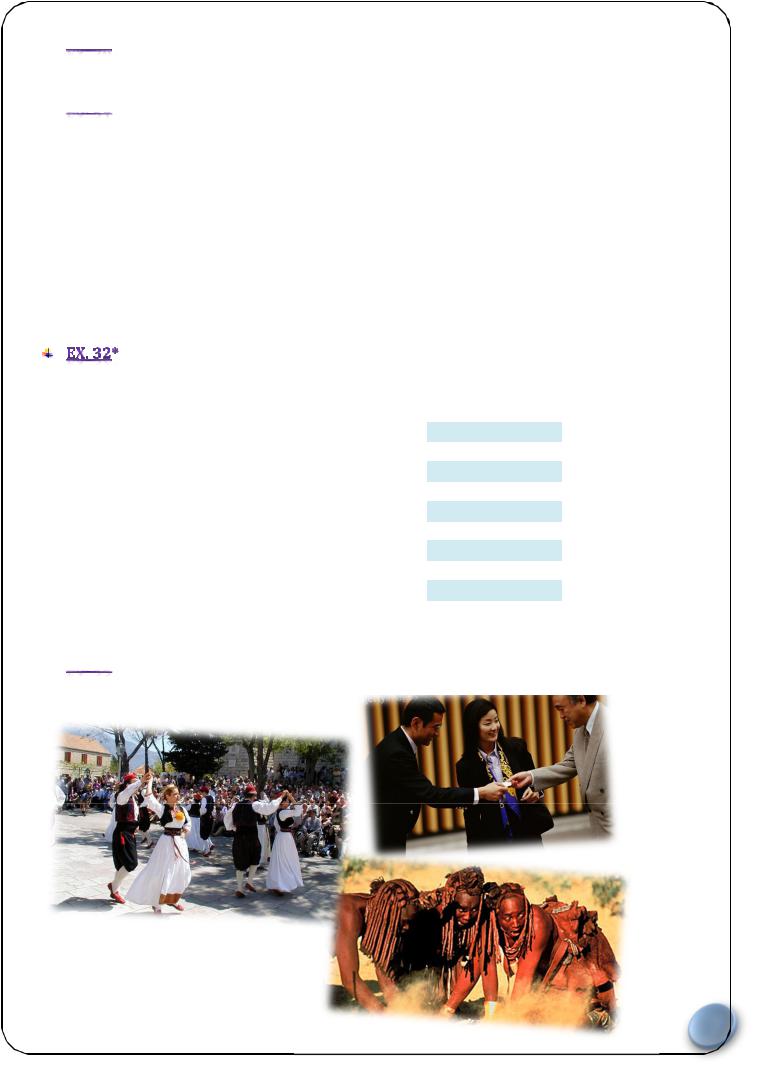


 Read the text again more carefully and note down any practical suggestions
Read the text again more carefully and note down any practical suggestions
on positive body language.


 Use the information in the text to complete the grid showing themessages
Use the information in the text to complete the grid showing themessages
which different postures send out. The first example has been done for you.
Posture |
|
|
|
Message |
|
||
smile |
|
|
'I am keen to communicate' |
|
|
|
|
arms/legs crossed |
|
|
|
|
|
|
|
open posture |
|
|
|
|
|
|
|
leaning forward |
|
|
|
|
|
|
|
leaning back |
|
|
|
|
|
|
|
warm handshake |
|
|
|
|
|
|
|
nod of the head/eye contact |
|
|
|
|
|
||
|
Collocate an adjective from list Awith a noun from list B to produce as many |
|
|||||
as possible. You can use the same noun with more than oneadjective. |
|
||||||
phrases |
|
|
|
|
|
|
|
|
|
strong |
|
|
|
|
|
|
|
friendly |
a. |
space |
|
|
|
|
|
open |
|
|
|||
|
|
|
b. |
attitude |
|
|
|
|
|
positive |
|
||||
|
|
|
|
c. |
situations |
|
|
|
|
nonverbal |
|
||||
|
|
|
d. |
problems |
|
|
|
|
|
conversational |
|
||||
|
|
|
|
e. |
signals |
|
|
|
|
receptive |
|
||||
|
|
|
f. |
step |
|
|
|
|
|
defensive |
|
||||
|
|
|
|
g. |
frame of mind |
|
|
|
|
personal |
|
||||
|
|
|
h. |
contact |
|
|
|
|
|
social |
|
||||
|
|
|
|
i. |
indication |
|
|
|
|
first |
|
||||


 In pairs,for each photo A-Cdiscussthe questions.
In pairs,for each photo A-Cdiscussthe questions.
Unit 4: Student’s Book
11
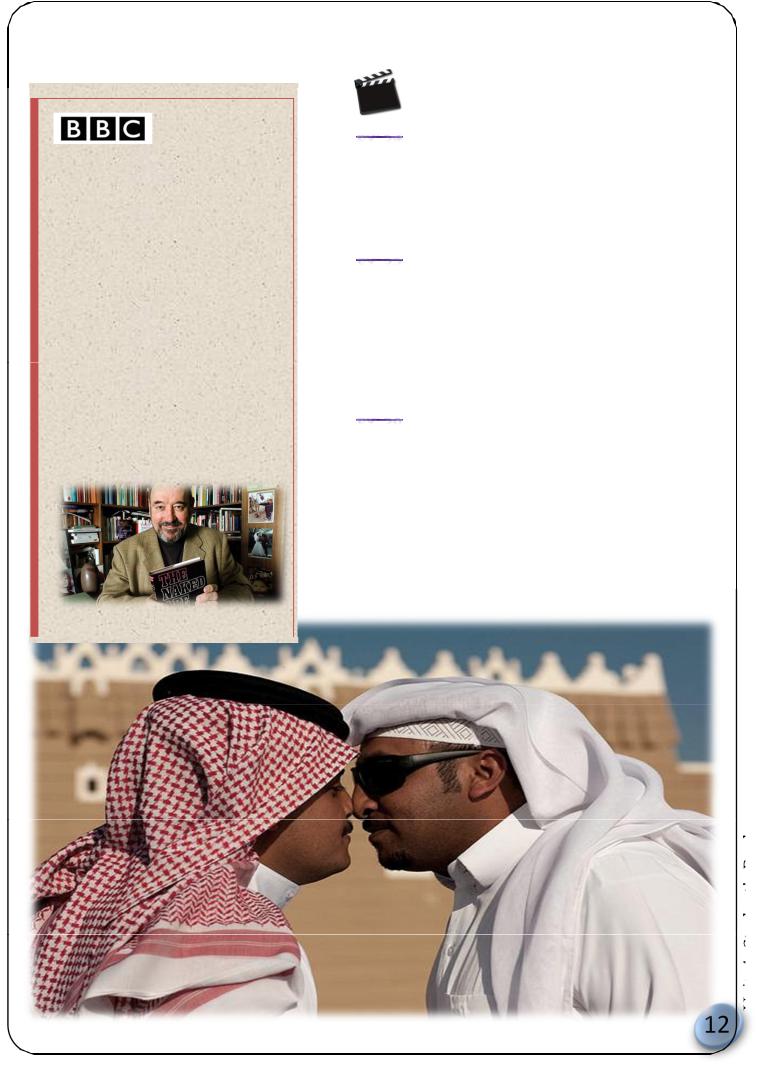
1.What kind of ritual can you see in each photo?
2.Do you do anything similar in your country?
The Human Animal
Desmond Morris is widely known for his study of human behavior, customs and rituals and his writings on the area, such as The Naked Ape, Manwatching and Christmas Watching. Originally a zoologist, Morris decided to observe and classify human behavior in much the same way as he would observe animals – in his words ‘to do for actions what dictionary markers had done for words.’ In this programme in the series, Morris focuses on customs connected with greetings and on the meaning of differentgestures.



 :Discuss.
:Discuss.
1.How many different ways of shaking hands do you
know?
2.How do you express ‘You’re crazy’ with your hands?




 :Watch theDVD and complete the sentenceswith numbers.
:Watch theDVD and complete the sentenceswith numbers.
Morris talks about:
1 …………. different handshakes
2 …………. different ways to express ‘You’re crazy’




 :Watch theDVD again and answer the questions.
:Watch theDVD again and answer the questions.
1.Why does Morris call himself a ‘man watcher’?
2.How long did it take him to complete his classification of human body language?
3.Why do Kurdish farmers in Turkey shake hands for so long?
4.What does Morris say the purpose of handshaking
is?
5.What are the different ways of saying ‘You’re crazy’
Unit 4: Student’s Book

Hometask 2


 Look at the drawings and try to match the bodylanguagewith the feelings.
Look at the drawings and try to match the bodylanguagewith the feelings.
A |
saying something important |
B |
|
C |
feeling attracted |
D |
feeling defensive |
|
feeling nervous |
E |
feeling superior |
F |
|
G |
being honest |
H |
lying |
|
thinking hard |

 Read thetext below and check your answers.
Read thetext below and check your answers.
Let your body do the talking
Oneofthe areas ofourbodywhich conveys mostabouthow wefeelis ourhands and arms. Hand and arm gestures aresometimes deliberate, butmostoften they occur unconsciouslyand naturally.
Openhands and arms, especially extended, and with palms upinfront of thebody at chest height, indicate that what you'resaying isimportant,and, especially whenpeoplearespeaking inpublic, a pointing fingerora hand waving abovethe shoulders emphasizes anindividualpoint However, research shows that peopleoften find speakers who point theirfingers a lot rather annoying.
When peoplewant to beopenorhonest they willoftenhold oneor both of theirpalms out to theotherperson.
Footballers who havejust committed a foul oftenusethis gestureto try to convincethe
referee that they didn't do it
a personputs his hand to his mouth, thiseitherindicates that heis hiding something, orthat heis nervous. Fidgetingwith yourhands, forexampletappingthetablewith yourfingers also shows nervousness, and so does holding a bag orbriefcasevery tightly infront of thebody.
Peoplewho feel superiorto you often appearrelaxed, with theirhands clasped behind theirheads. Thechin and head is oftenheld high. This gestureis typicalof lawyers, accountants,and otherprofessionals who feelthey know morethanyou do. Anothergestureof superiority is to put yourhands inyourpockets with thethumbs protruding. Feeling defensive Arms folded tightly overthechest is a classic gestureof defensiveness and indicates that you are protecting yourself. It is oftenseenamong strangers inqueues orin lifts oranywherewherepeoplefeela bit insecure. Peoplealso sometimes usethis gesturewhenthey arelistening to someone, to show that they disagreewith what is being said. However, this gesturecansimply meanthat thepersonis cold!
Thinking hard A hand-to-cheek gesture, wheresomeonebrings a hand to his faceand extends his index fingeralong his cheek, with theremaining fingers positioned below themouth, oftenshows that someoneis thinking deeply. When someonestrokes his chin, heis probably thinking about something important, ormakinga decision.
AttractionIf menareattracted to someone, they sometimes play with oneof theirearlobes, whereas womenwillplay witha lock of hairorcontinually tuck theirhairbehind theirears.
Lying Therearemany gestures that indicatethat someoneis lying and inorderto besureyou would expect a personto show morethanone. Gestures includeputting yourhand infront of yourmouth, touching yournose, rubbing youreyes, touching yourear, scratching yourneck, pulling at yourcollar, orputting yourfingerorfingers inyourmouth.

 Write a summaryof the text in exercise 29.
Write a summaryof the text in exercise 29.

 Vocabulary Practice (teacher’s instruction)
Vocabulary Practice (teacher’s instruction)
13
Unit 4: Student’s Book
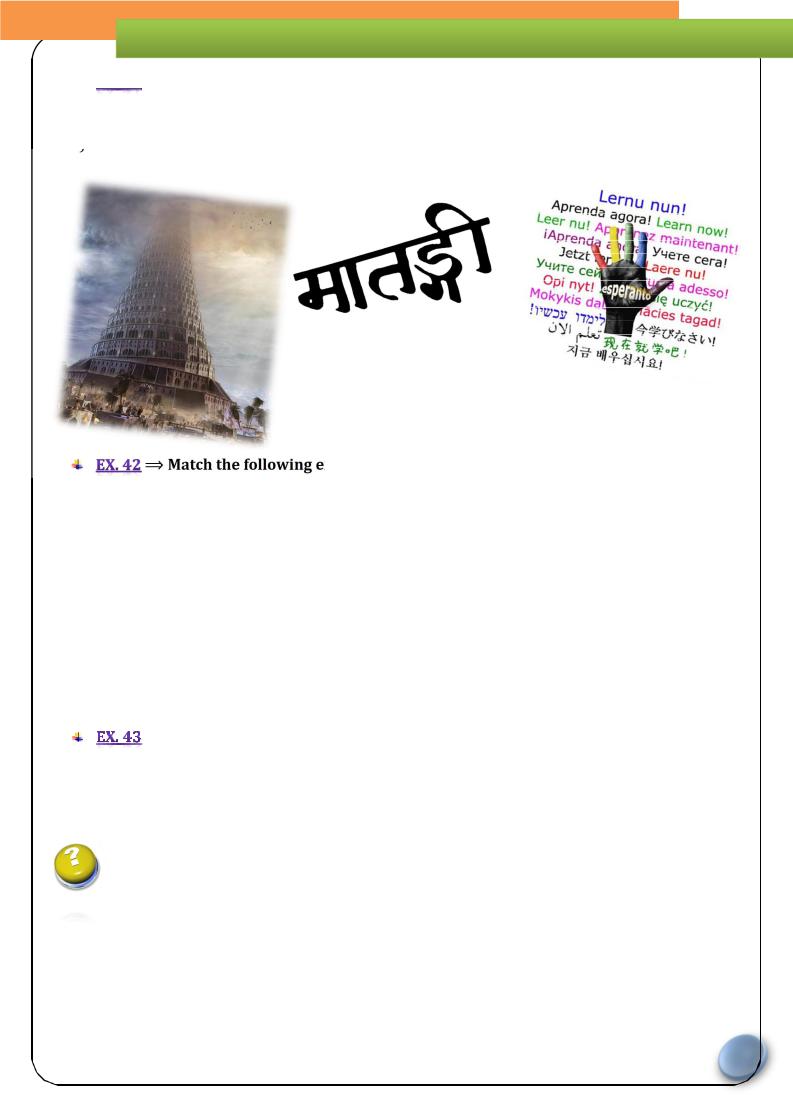
Theme Two: Whose Language?

 In what ways arethe following relevant to thehistory of communication?Discuss
In what ways arethe following relevant to thehistory of communication?Discuss
your ideaswith your partner. |
b) Sanskrit |
c) Esperanto |
a) The Tower ofBabel |
explanations with points a), b) and c) in Activity 1 above.
1)Many different languages, including English, originate from this ancient language. It was used for about 3,000 years in India until the 19th century when modern Indianlanguages such as Hindu and Bengali became more popular.
2)There is a story which says that a long time ago people used to speak one language. They worked together to construct a building high enough to reach their paradise. Their god saw this and was angry. He stopped them by giving them different languages so that the builders couldn't understand each other.
3)This is an artificial language which was invented in 1887 by a Polish doctor called Zamenhof. It has no irregular verbs! Between two million and eight million people can speak this language.
|
Use the following questions to begin a conversation with your partner. |
|
1. |
Would you like to be able to speak Esperanto? Do you think Esperanto is the language of the |
|
2. |
future? Why/not? |
|
3. |
Why do languages die out (e.g. Latin)? Do you think English will ever die out? Why/not? |
|
|
How different wouldlife be different if we all spoke the same language? What would be the |
|
|
advantages and the disadvantages? Do you think that speaking one language could bring |
Book |
4. |
people of different nations closer together and improve the chances of world peace? |
|
5. |
Approximately 1 in4 people speak Chinese. In many countries Spanish is the first language. |
4:Student’s |
global language? |
||
|
In the lightof this informationdo you think English is the best choice for an international |
|
|
language. Why/not? What are the advantages and disadvantages of using English as the |
|
|
With your partner, suggest ways to make the English language easier to learn (e.g. abolish |
|
|
irregular verbs so 'bought' = 'buyed'). |
Unit |
14


 Read the Text.
Read the Text.
TheEnglishlanguage
How many people can speak English? Some experts estimate that 1.5 billion people-around one-quarter of the world's population - can communicate reasonably well in English.
English belongs to the Indo-Europeanfamily of languages, which developed from a parent language first spoken about five thousand years ago in central-northern Europe. From there, it spread to the rest of Europe and the Middle East, and overtime:it developedinto a series of new tongues. One of these was Primitive Germanic, which later split into old English, Dutch, German and the Scandinavian languages. Old English was later heavily influenced by French following the Norman invasion in the eleventh century. Then, in the sixteenth century, due to the invention of printing, the increase in opportunities for education and the growth of international trade and communication, this form of English, which is known as Middle English, changed into the language we now speak, Modern English. Events such as the Industrial Revolution and the two world wars are among the reasons for the expansion of vocabulary. The media has dramatically contributed to the growing factorand influence of the English language.
Indeed, never in recorded history has a language been as widely spoken as English is today. The reason why millions are learning it is simple: it is the language of international business and therefore the key to prosperity. It is not just that multinational companies such as Microsoft, Google, and Vodafone conduct their business in English; it is the language in which the Chinese speak to Brazilians and Germans to Indonesians.
David Graddol, the author of English Next, says it is tempting to view the story of English simply as a triumph for its native speakers in North America, Britain and Ireland, and Australasia - but that would be a mistake. Global English has entered a morecomplex phase, changing in ways that the English-speaking countries cannot control and might not like.
An important question one might ask is: whose English will it be in the future? Non-native speakers now outnumber native English speakers by three to one. The majority of encounters in English today take place between non-native speakers. According to David Graddol, many business meetings held in English appear to run more smoothly when there are no native English speakers present. This is because native speakers are often poor at ensuring that they are understood in international discussions. They tend to think they need to avoid longer Latin-based words, but infact comprehensionproblems are more often caused by their use of colloquial English, especially idioms, metaphors, and phrasal verbs. On one occasion, at an international student conference in Amsterdam, conducted in English, the only British representative was asked to be 'less English' so that the others could understand her. So, the language does change. It's onthemoveallthe time. What brings thesechanges?
Political correctness has made and continues to make a significant impact on the English language as we are all encouraged, for the common good, to make increasing use of euphemistic paraphrase. We should turn our backs on expressions like “the poor” and embrace “the economically disadvantaged”. “The visually challenged” is recommended in the place of “the blind”; “the chronically hard of hearing” is suggested as substitute for “the deaf”. The euphemism, an inoffensive or positive word or phrase designed to avoid a harsh, unpleasant, or distasteful reality. It can also be a tactful word or phrase; for example, "pass away" functions not just to protect the feelings of another person but also to express our concern for another's grief. This is all well and not asking the impossible of us. It is rather when the trend is taken to the extreme and “the bald” find themselves referred to as “the follically challenged” that there is a risk of things getting out of hand; if a euphemism is used to mislead or deceive, however, a euphemism becomes doublespeak.
Doublespeak is a blanket term for language which pretends to communicate but doesn't, language which makes the bad seem good, the negative appear positive, the unpleasant attractive, or at least tolerable, it is language which avoids shifts or denies responsibility, language which is at variance with its real meaning. Attentive observers of theEnglish languagealso learned recently that the multibillion dollar stock market crash of 1987 was a simply “a fourthquarter equityretreat”;that airplanes don't crash they just have “uncontrolled contact with the ground”.
In other words, doublespeak continues to spread as the officiallanguageof publiccommunication.
Jargon, the specialized language of a trade or profession, allows colleagues to communicate with each other clearly, efficiently and quickly. Indeed, it is a mark of membership to be able to use and understand the group's jargon. But it can also be doublespeak – pretentious and obscure terminology used to make the simple appear complex and not to express but impress. Lawyers and tax accountants speak of an “involuntary conversion” of property when discussing the loss or destruction of property through theft oraccident.
Neologisms, new words or new ways of using familiar words, seem to be appearing in the language with everincreasing speed, so that one can expect to encounter an unknown element in the newspapers or in broadcasts at least once a month. Neologisms are said to be the most acute barometer of the course English culture is taking. The Nineties havegiven the languagean armoury of neologisms
– be they genuine attempts to define new cultural phenomena, or outlandish euphemisms dictated by political correctness or marketing agendas. Marital status has its own labelling, as you will know if you are a ‘sinbad” (single income, no boyfriend, absolutely desperate) or even a “sitcom” (single income, two children and an
oppressivemortgage).
15
Unit 4: Student’s Book
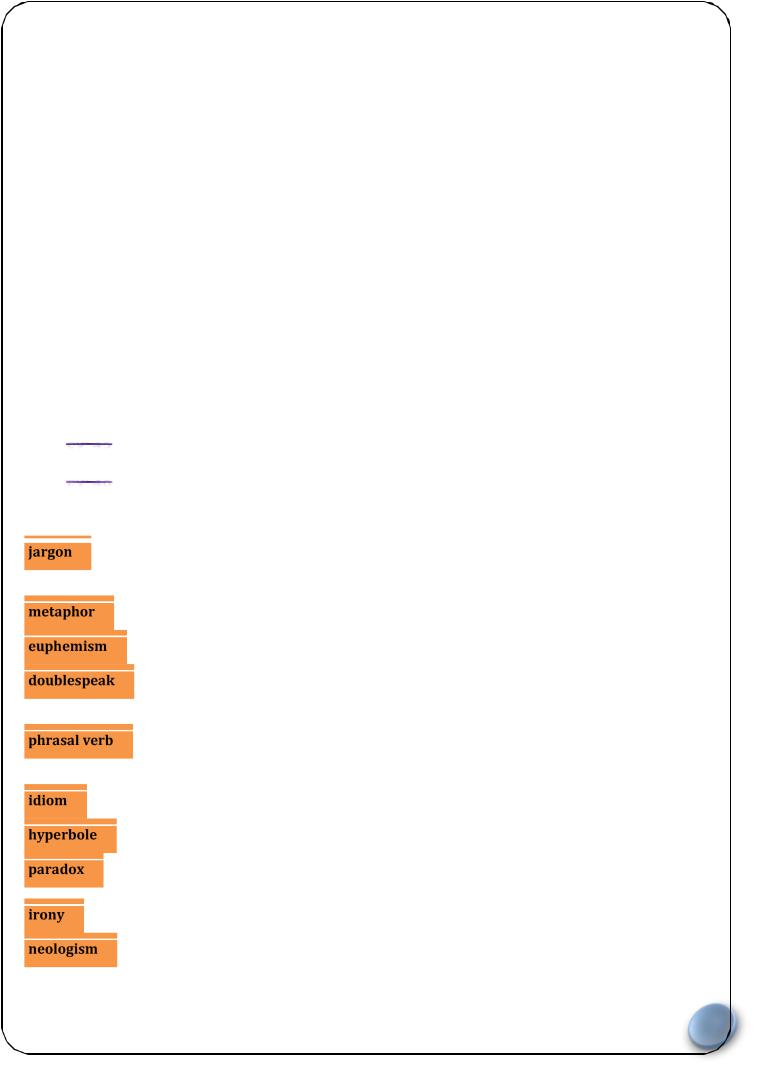
“England and America are two nations separated by the same language”, said George Bernard Show, the British playwright, when in his usual witty mood. The difference between British and American English can be exaggerated. In the spoken language there is the question of pronunciation, which makes the two forms instantly distinguishable from each other; but in the written language there is astonishingly little that would indicate to the reader whether he is dealing with a British or an Americanauthor– provided that direct speech is omitted. Professor Barbara Setdlhofer, Professor of English and Applied Linguistics at the University of Vienna, records and transcribes spoken English interactions between speakers of the language around the world. She says her team has noticed that non-native speakers are varying standard English grammarinseveralways. Eventhemost competent speakers sometimes omit the 's' in the third person singular. Many omit definite and indefinite articles where they arerequired instandard English, orput them inwhere standard English does not use them. Nouns that are not plural in native-speaker English are used as plurals by nonnative speakers (e.g. 'informations', 'knowledges', 'advices'). Other variations include 'make a discussion', 'discussabout something' or'phoneto somebody’.

 Answer the teacher’s questions.
Answer the teacher’s questions.
Many nativeEnglish speakers willinsist that thesearenot variations, they are mistakes. 'Knowledges' and 'phone to somebody' are simply wrong. Many non-native speakers who teach English around the world would agree. But language changes, and so do notions of grammatical correctness.
Those who insist on standard English grammar remain in a powerful position. Academics who want their work published in international journals have to adhere to the grammatical rules followed by native English-speaking elites. But spoken English is another matter. Why should non-native speakers bother with what native speakers regard as correct? Their main aim, after all, is to be understood by one another, and in most cases there is no nativespeakerpresent.
Professor Seidlhofer says. 'I think that what we are looking at is the emergence of a new international attitude, the recognition and awareness that in many international contexts non-native speakers do not need to speak like native speakers, to compare themselves to them, and thus always feel'less good.'

 Match thetermini below with their definitions and illustrating examples.
Match thetermini below with their definitions and illustrating examples.
terminus |
|
|
|
definition |
|
|
example |
|
|
|
|
|
|
|
|
|
|
|
|
|
|
|
|
|
|
|
|
|
|
a) |
Language that deliberately disguises, distorts, or |
1. |
Nowadays banks don't have 'bad loans' or |
||
|
|
|
|
reverses the meaning of words. It may take the form |
|
|
'bad debts' - they have 'nonperforming |
|
|
|
|
|
of euphemisms, making the truth less unpleasant, |
|
|
assets' and 'nonperforming credits'. |
|
|
|
|
|
without denying its nature. |
|
|
|
|
|
|
|
|
|
|
|
|
|
|
|
|
b) |
It consists of a verb and a preposition or an adverb |
|
2. |
I came across this book in a little store. |
|
|
|
|
|
that modifies or changes the meaning. |
|
|
|
|
|
|
|
|
|
|
|
|
|
|
|
|
c) |
The specialized or technical language of a trade, |
3. |
If you don’t know something, you can |
||
|
|
|
|
profession, or similar group. |
|
|
always google it. |
|
|
|
|
|
|
|
|
|
|
|
|
|
d) |
A set expression of two or more words that means |
|
4. |
For example, in politics non-executive |
|
|
|
|
|
something other than the literal meanings of its |
|
|
members of the party are referred to as |
|
|
|
|
|
individual words. |
|
|
“back benches”; in the medical field “BP” |
|
|
|
|
|
|
|
|
stands for blood pressure |
|
|
|
|
|
|
|
|
|
|
|
|
|
e) |
Coded expressions that we use when whatever we |
5. |
“All the world's a stage, |
||
|
|
|
|
are referring to is considered inappropriate for the |
|
|
And all the men and women merely |
|
|
|
|
|
circumstances or when we are embarrassed or |
|
|
players. |
|
|
|
|
|
uncomfortable with the literal version. |
|
|
|
|
|
|
|
|
|
|
|
|
|
|
|
|
f) |
Expressing a meaning directly contrary to that |
|
6. |
They must go to war to make peace. |
|
|
|
|
|
suggested by the words. |
|
|
|
|
|
|
|
g) |
A seemingly self-contradictory statement, which yet |
|
7. |
“To make something sound better” instead |
|
|
|
|
|
is shown to be true. |
|
|
of “to lie”. |
|
|
|
|
|
|
|
|
|
|
|
|
|
h) |
Exaggerated or extravagant statement used to make |
|
8. |
It’s such a thrill to find out that I’ll be |
|
|
|
|
|
a strong impression, but not intended to be taken |
|
|
spending the summer with a cast on my |
|
|
|
|
|
literally. |
|
|
leg! |
|
|
|
|
|
|
|
|
|
|
|
|
|
i) |
A newly coined word, or a phrase or familiar word |
9. |
It was a piece of cake to get that job. |
||
|
|
|
|
used in a new sense. |
|
|
|
|
|
|
|
|
|
|
|
|
|
|
|
|
j) |
A figure of speech in which an implied comparison is |
|
10. |
I have a million things to do today. |
|
|
|
|
|
made between two unlike things that actually have |
|
|
|
|
|
|
|
|
something in common. |
|
|
|
|
|
|
|
|
|
|
|
16 |
|
Unit 4: Student’s Book


 Studythe note below and do the exercise.
Studythe note below and do the exercise.
Euphemismsmightcome quite handyif you happento find yourself inanewor intercultural environment. Speakers employthis technique toavoidusingwordsthathave a negative stigma attachedto them,to avoidoffending othersby speaking of taboo or sacred subjectsdirectly, to over-inflate theimportance of certainwords.
EuphemismsUsed to Soften Language
Fat = overweight, full-figured, big boned, chubby, plump, etc.
Poor= working class, of modestmeans, of humble origins, low-income,unable tomake endsmeet, in debt, etc.
Handicapped = disabled, differentlyabled,physicallychallenged, disadvantaged, etc.
EuphemismsUsed to InflateorMislead
Garbagecollector= waste disposal worker, sanitationworker, wastemanagement, etc. Secretary = administrative assistant, clerical assistant, executive assistant, personal assistant,etc.
euphemism |
|
|
definition |
|
|
|
a) |
to flatter |
|
|
|
|||
|
|
|
||
|
|
b) |
to criticize |
|
|
|
|
||
|
|
c) |
suppression of information |
|
|
|
|
||
|
|
d) |
nakedness |
|
|
|
|
||
|
|
e) |
supplementary money paid on leaving a job |
|
|
|
|
||
|
|
f) |
become unemployed |
|
|
|
|
||
|
|
g) |
a lodger |
|
|
|
|||
|
|
|
||
|
|
h) |
military attack |
|
|
|
|
||
|
|
i) |
dead |
|
|
|
|||
|
|
|
||
|
|
j) |
stolen |
|
|
|
|
||
|
|
k) |
drunk |
|
|
|
|
||
|
|
l) |
mental or physical defect |
|
|
|
|
||
|
|
m) |
lying |
|
|
|
|||
|
|
|
||
|
|
n) |
venereal disease |
|
|
|
|
||
|
|
|
|
|

 In pairsor small groups discussthe following questions.
In pairsor small groups discussthe following questions.
1)What do you think the future of theEnglish language will be? Will itremain the language of international communication?
2)Do you think it is necessary to preserve the English language and strictly follow grammar rules, or shouldwe accept that nowadays non-native speakers do not need to speak like native speakers
3)Do you think English is easier or more difficult to learn than other foreignlanguages?
17
Unit 4: Student’s Book

|
: In what way do you thinkthe English language is changing now?Please, |
note thesechanges and discuss them in pairs.
|
|
|
|
|
|
:Watch theDVD anddecidetrue √, |
|
|
|
whether the information in the statements below is |
|
||||
Rap |
false |
|
or not given −. |
|
|
||
|
|
|
|
|
|||
|
|
|
1) Professor Sara Campbell considers the English language |
|
|||
Rap music originated in the late |
|
|
to be very dynamic due to the fact it is constantly |
|
|||
1970s and has had a big influence |
|
|
changing. |
|
|
||
|
|
|
|
||||
on the English language by creating |
|
2) Daniel Believes that the language of hip-hop is easy for |
|
||||
a wide range of new vocabulary |
|
|
everyone to understand. |
|
|||
|
|
|
|||||
and expressions. However, due to |
|
3) Daniel and Sara both believe that the language of hip-hop |
|
||||
the obscurity of the language, there |
|
|
will remain in use for a long time to come. |
|
|||
|
|
|
|||||
have been many attempts to create |
|
4) Professor Sara Campbell’s students always use thecorrect |
|
||||
dictionaries to help people |
|
|
level of formality when they address her. |
|
|||
|
|
|
|||||
decipher the new terminology. The |
|
5) Daniel thinks the hip-hop dictionary is a great way to keep |
|
||||
term “hip-hop” is generally used to |
|
|
up-to-date withthe language of rap. |
|
|||
|
|
|
|||||
describe the whole lifestyle that |
|
|
|
|
: Answer the following questions. |
|
|
surrounds rapping; such as graffiti, |
|
|
|
|
|
|
|
break dancing, fashion, DJs and rap. |
|
1) Why does Professor Sara Campbell consider English |
|
||||
“Rap” generally describes the art of |
|
|
|||||
singing in a particular style, as in |
to be an especially interesting and rich language? |
|
|||||
“He’s been rapping for 15 minutes”. |
|
2) Why is rap a wonderful example of how the language |
|
||||
|
|
is growing? |
|
|
|||
|
|
|
3) How did rap start out? |
|
|||
|
|
|
4) Why is it necessary to keep to different language |
|
|||
|
|
styles when talking to your boss and when talking to your |
Book |
||||
|
|
friends? |
|
||||
|
|
|
5) What choices do dictionary-makers have to make |
4:Student’s |
|||
8) |
|
when publishing a new dictionary? |
|||||
How is your native language changingover time? |
|
||||||
6) |
How do dictionary-makers decide whether to include a new word or not? |
|
|||||
7) |
How can you keep up-to-date with new words in English? |
|
|
||||
|
|
|
|
|
|
|
Unit |

Hometask 3: English Mania



 :Answer the following questions.
:Answer the following questions.
1)At what age do you think it is necessary to start teaching a child English?
2)Is it possible to be successful in our contemporary world without the knowledge of the English language?
3)Do you think test scores show the real knowledge of the language?


 :Watch thevideo on theworld’sEnglish mania.Decidewhether the statements below are True √or False .
:Watch thevideo on theworld’sEnglish mania.Decidewhether the statements below are True √or False .
1)Manias can be alarming and deadly.
2)Chinese students practice their English by signing it.
3)If you are a Chinese student you start learning English in the third grade, by law.
4)Chinese students take the Gaokao test for three full days.
5)50 percent of the grade on the test is based on English.
6)The world doesn’t have any other universal languages.
7)English is becoming the language of problem-solving because America is pushing it.
8)To many people English represents hope for a better future.
 Find English equivalents to the following words/ word combinationsfrom the video .
Find English equivalents to the following words/ word combinationsfrom the video .
восторг,восхищение
разочаровывать, подводить
определять, обусловливать будущее
ужасный, суровый, истощающий(о тесте) 
перелом, решающий момент
проведениеэлектричества
решать общиепроблемы



 : Answer the questions.
: Answer the questions.
1)Do you agree with Jay Walker that there is such a phenomenon as theworld’s English mania?
2)Do you think a mania for learning English is a good thing or a bad thing? Give your reasons.
3)What universal languages exist today?
4)What evidence is there that English is becoming increasingly importantin the world?
5)What do you think will happen to English as it spreads to non-English-speaking regions?
6)Are there any tests in your country which are similar to the Gaokao test in China?
19
Unit 4: Student’s Book
